An Unexpected Turn - Part 3
The Decision
Start here: An Unexpected Turn, Part 2: The Doubt
The phone call with the fertility doctor was almost a moot point. In the two days I’d spent driving from Utah’s red rock country through Colorado’s Rocky Mountains, climbing 12,000-foot Loveland Pass in a bumper-to-bumper crawl of semi trucks detoured off Interstate 70, I had listened to enough books about the challenges of parenthood that I was all but convinced to cancel our donor-egg IVF procedure. I chafed at paying $200 for the telehealth visit since Seth and I were so uncertain about moving forward, but I’d waited five weeks to see Dr. Brown, since that fateful day in the Mojave when donor #1111234 had arrived in my Inbox.
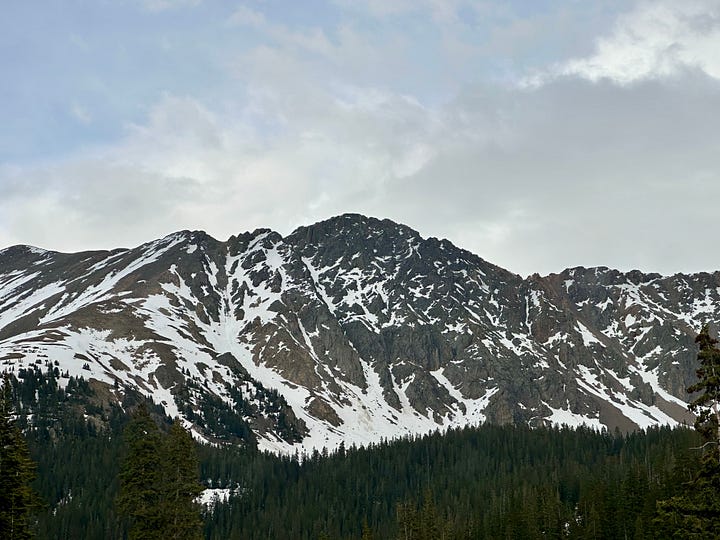

The phone call almost could have happened in the same room in the same friend’s house in Denver where I’d decided two years earlier to cut my Alaska-to-Baja trip short and go home to pursue adoption. But the detour off the interstate made it hard to predict when I’d pass through town, and a torrential thunderstorm bore down as I finally approached Denver at dusk, so I made the disappointing decision not to bother my friend Sarah and her family at 9pm in the middle of a deluge. Instead, I continued in a northerly arc on the outskirts of town and drove until I found a rest area. The Rocky Mountains gave way to the Great Plains in a dramatic shift, and I felt like I was in Nebraska long before I crossed the state line.
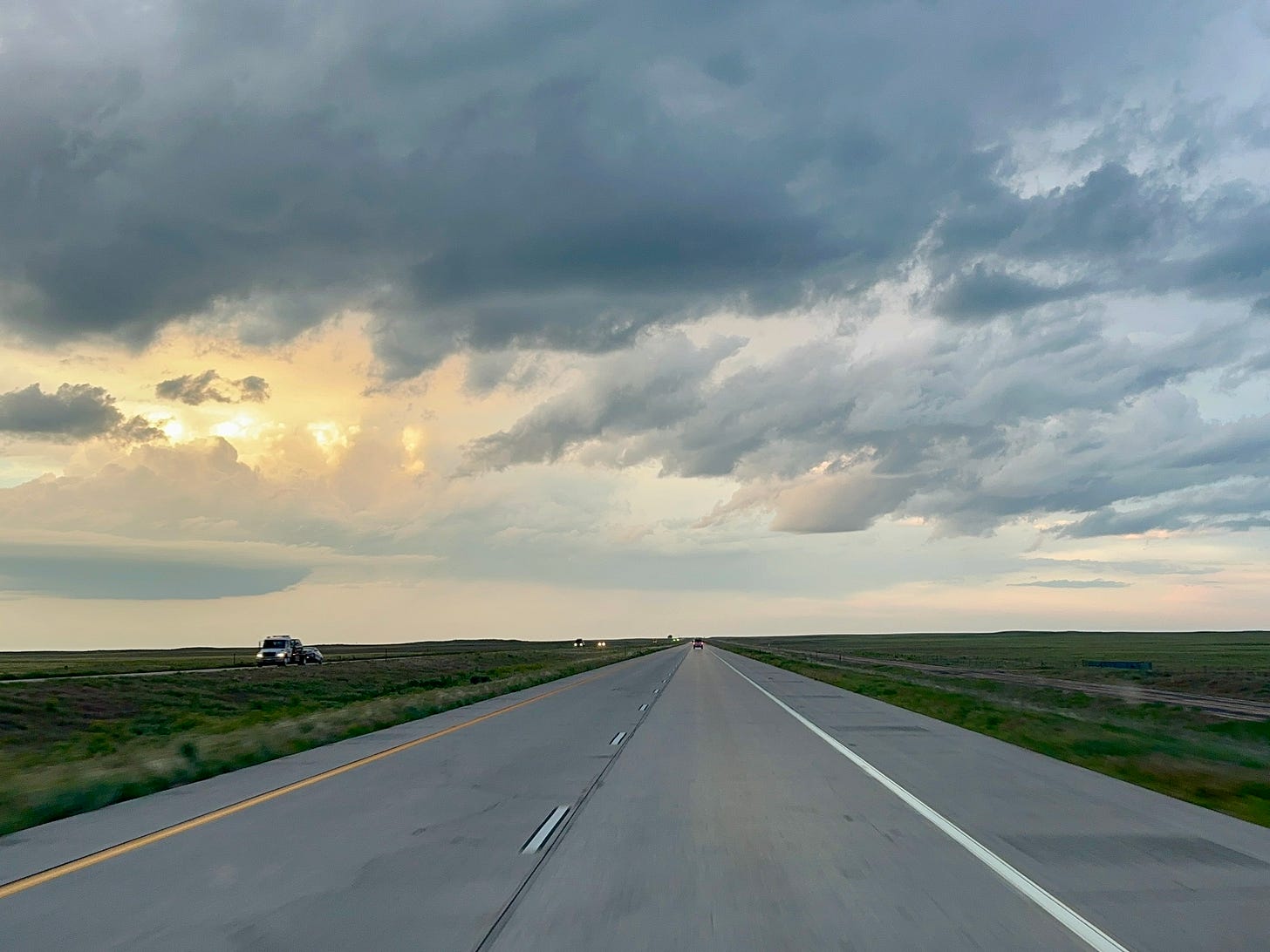
That rest area in Julesburg, Colorado was my last chance to change course; in theory, I could still retreat up the spine of the Rockies toward Banff and Jasper National Parks in Canada and on to the Alaska Highway, retracing in reverse the drive I’d made in October 2023 when I thought I would continue south from Alaska to Baja. I considered this as I sat in my van in the rest area’s RV parking after spending the night next to a picnic table and trash can, waiting for the text from the clinic with a link to my telehealth with Dr. Brown.
I’d thought my doctor’s appointment would present me with a final deadline to pay our deposit and commit to our donor, perhaps once my tests were complete in the next couple weeks. Instead, I was surprised when Dr. Brown informed me that the third-party coordinator at our clinic had already relisted our donor in the database since we hadn’t yet made a five-figure deposit, and that this was OK because she could donate up to six times, so even if someone else claimed her, it would just mean waiting a couple months for her to be ready to cycle again. I knew it wasn’t so simple—would this woman want to go through six different egg retrievals for six different families? Knowing that there was no more decision to make—at least not anytime soon—made my stress and urgency of the past five weeks seem silly. It turns out, I could have continued north from Baja and spent the summer in Alaska and probably still claimed my donor when I returned. In fact, I could still change course now without losing my preferred donor. How did I not realize this? Should I have asked?
But for all the reasons I’d come up with before, going home for the summer seemed to make sense even if we weren’t going to pursue IVF. Momentum kept me heading east toward home, along with the promise of kisses and snuggles from the husband I hadn’t seen in three months. Alaska would always be there, I reasoned. The things I was going home for may not be.
I braced myself for the next five days of driving. I decided I could realistically make 350 miles a day in my van, equaling about five driving hours plus a couple hours of stops for lunch, dinner, and dog walks. This would let me sleep late enough to start the day well-rested, and arrive at my destination before dark.
With the Colorado Rockies in my rear view, I headed east across the Nebraska plains, stopping at dark just across the border in Council Bluffs, Iowa to enjoy a massage chair and shower at a 24-hour Planet Fitness. I spent the night in the gym’s parking lot next to a gravel median. When I emerged the next morning to walk the dogs, it was 88 degrees in the van with 50% humidity—the hottest I’d felt on the whole trip. A sticky layer coated my dry desert skin, and the air was thick enough to taste. Across the street from the strip mall, I found a sidewalk skirting a neighborhood like any I might have walked back home in New Hampshire—green leaves popping from bushes and shrubs; green branches leaning overhead; green grass covering fenced-in lawns and the margins of sidewalks. It reminded me of a walk near the house I grew up in, and my soul settled for the first time in six months. I had crossed the Missouri River. I was still 1,500 miles from home, but I was officially back East!
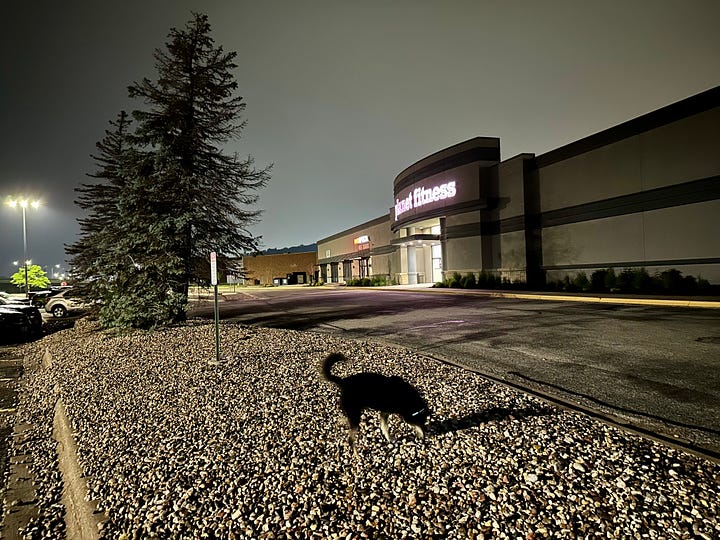
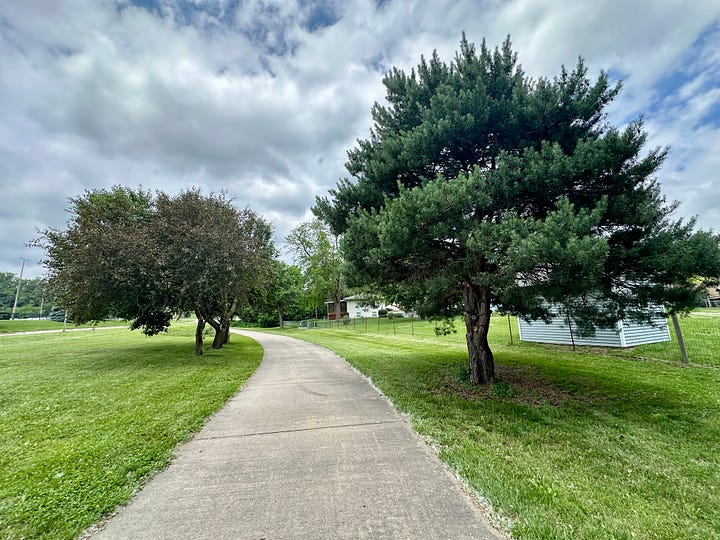
The greenery—and humidity—continued through the rolling farmland of Iowa and Illinois and into the industrial belt of the Great Lakes, as Interstates 80 and 90 skirted Lakes Michigan and Erie and the highway bloated from two lanes to four in each direction. My tired arms strained to hold the wheel as the semi trucks passed, pushing puffs of air under my solar panels that tossed my van sideways. I white-knuckled when I passed them as well, anticipating the displaced air and bracing myself against the push. Traveling at night wasn’t much easier, as the trucks also preferred to avoid daytime traffic. Each night I drove later, pulling in around 10pm,11pm, or midnight at a rest area, Walmart parking lot, or Planet Fitness, walking the dogs, and tucking myself in for the night.
In the home stretch, my route took me through the heart of the Adirondacks toward Baxter’s vet in Burlington, Vermont. I stopped at a lakeside park in upstate New York and frolicked across the grass with the dogs, dodging goose poop and giggling with excitement at my arrival in the Northeast. I marveled how six months out West could make places as foreign as Council Bluffs, Iowa and Speculator, New York feel like home.
A few hours later, I crossed the Crown Point bridge over Lake Champlain into Vermont, and I was officially on my home turf of New England. The sun had begun to set, and I realized I was only 20 minutes away from another friend’s house, but it felt strange to stop by at this hour so out of the blue. Plus, pushing 2,200 miles since Moab had drained all the energy out of me. I needed a shower and a massage chair and a parking spot, and I found these at Planet Fitness in South Burlington. I resolved to reach out to my friend the next time I was in Vermont.
I awoke the next morning to a knock—THE Dreaded Knock that plagues all van-lifers at some point in their journey—the knock that says You Don’t Belong Here. I had assumed I could get away with overnighting at a 24-hour facility, but apparently not. I had my strategy, though: ignore, and pretend I was in the gym. The dogs kept quiet, but even if they had barked, this strategy still checked out. The knock silenced, and by the time I changed out of my pajamas into my workout clothes (to act like I was about to go into the gym) and peeked out my van curtain, no one was in sight. I quickly switched everything into drive mode and scooted away, making the dogs wait to pee until we arrived at the vet office ten minutes later. I smirked at the irony that my first-ever knock in nearly a year of cumulative van life happened on the last morning of my trip.
* * * * *
Three weeks of family commitments, medical appointments, catching up with friends, unpacking, and repacking passed in an exhausting blur, and the next thing I knew, I was floating on my inflatable lounge chair next to the island on Spofford Lake. I had known that I would hit the ground running as soon as I got home, and it was as intense as I’d imagined. It was nearly a month after my return before I could finally lounge on the lake as I’d dreamed of since Tahoe, and sit on the deck outside my 1991 Winnebago in my in-laws’ driveway in New Hampshire writing about my reasons for coming home.
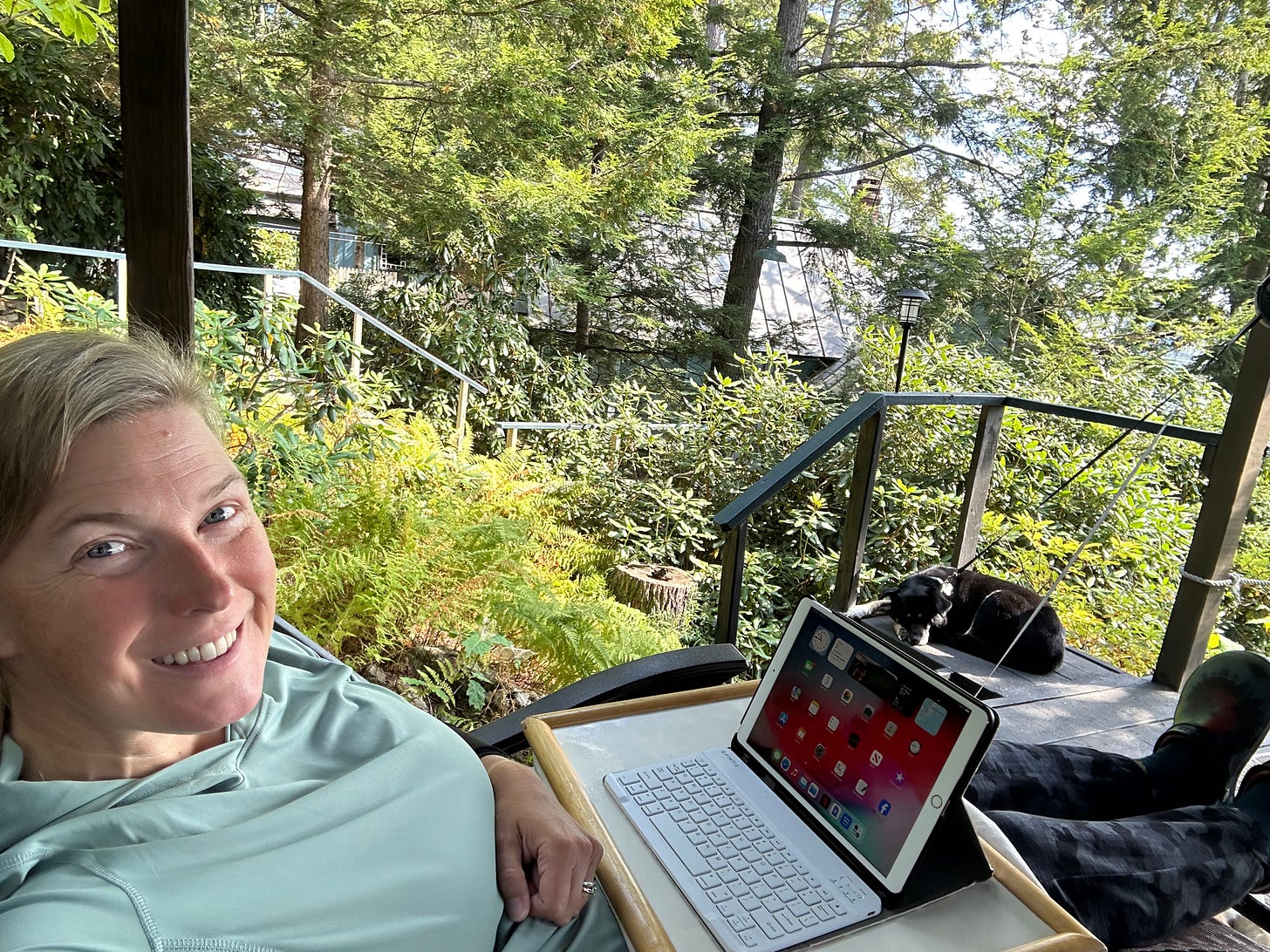
The fertility tests had turned out fine; my uterus was intact, my mammogram and EKG were normal, my blood work checked out, and everything was good to go if we decided to proceed with donor-egg IVF. What those tests did not detect, however, were the subtle shifts in my heart and mind as I’d headed east, and the realizations I’d had once I got home.
As I floated on my tube on a sunny, 80-degree afternoon the day before the Fourth of July, families began arriving for the long weekend and occupying the spaces adjacent to me on the island. A dad paddled a canoe with his young son and daughter and landed nearby, then spent ten minutes swimming and digging for clay in the lake bed before corralling the kids back into the boat. A mom and dad pulled up in a speedboat with their three teen boys and anchored offshore, mom diligently spraying sunscreen across the boys’ pasty-white torsoes before they set off wading in the shallows with fishing poles.
One after another, over the course of four hours, I watched families come and go, making anthropological observations on the American family unit. Would I want to be them, I wondered, as I floated peacefully by myself? One mom rounded the tip of the island in a paddleboard flotilla with her tween daughters. As the girls disembarked their boards to swim, mom eagerly flopped on hers to lounge in the sun. Within moments, one of the daughters came over and demanded that mom surrender her board so that she could lie on it. Mom obliged and instead stood in the cold water, holding the board for her daughter. Would I have martyred myself as readily in that scenario? Or would I have reminded my daughter that she had her own board she could lounge on beside me? Would that have resulted in the kind of bickering and whining that had perhaps trained this mom that giving in was the path of least resistance?
Being at the lake brought back memories, too. July Fourth was the one-year anniversary of the last time I’d seen our two young foster kids. Our week-long summer visit with them had gone well—thanks to daycare and camp—until we got to the lake. I had awoken to the sound of the one-year-old girl screaming for strawberries and the four-year-old-boy chattering nonsensical questions while Seth tried to make oatmeal for breakfast. I had pretended to stay asleep, even though in our camper, my bed was four feet from the kitchen counter. All I wanted to do was escape for a quiet morning on the deck overlooking the lake—despite finally having the full house that I thought I’d always wanted. The overstimulation that day pushed me to a breaking point, and we made the heartbreaking decision not to move forward with our pre-adoptive placement.
So the Fourth of July was extra bittersweet, but the memories also highlighted how spoiled I was to be able to sit and relax whenever I wanted; to do what I wanted to do; to stay up late and sleep in, or get up for sunrise and go to bed early; to live some hybridized version of college life and retiree life. What even is it to be 45 and childless? I was still figuring that out.
My body registered more data on the baby question when I attended my friend Anne’s baby shower. I was so happy that she’d gotten pregnant after an infertility journey as long and fraught as my own, but I wondered how I would do being immersed in the celebration. I rolled up to the restaurant in The Dream Catcher, my 1999 Roadtrek camper van, fresh off my long drive east. Anne and I knew each other from a job I left a decade ago, and she seated me at a table with her high school and college friends. They responded to my travel tales with awe and admiration, which was exciting for me, since it was the first time I’d talked about my trip with strangers who weren’t also on the road. Anne’s friends could not believe that I’d driven solo to Mexico. They told me I was brave. It was the first time I’d felt validated for my choices—ironically, among a group of women celebrating our friend’s pregnancy.
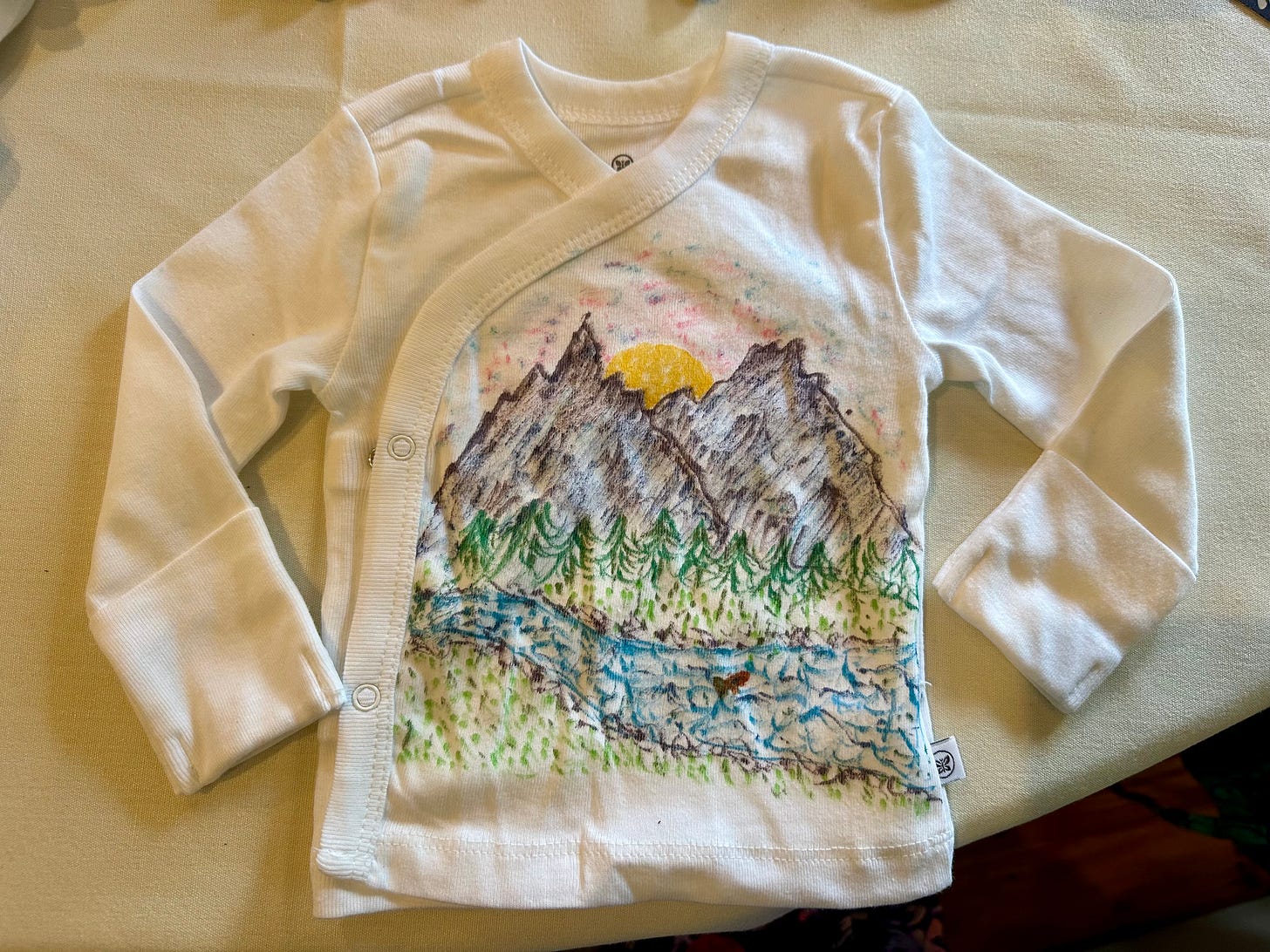
The experience of rolling up to a baby shower in the Roadtrek had me feeling like a badass, but I found the event itself to be terrifying. I overheard a mom in our circle talking about her entire family getting sick on vacation. Then Anne’s sister gave Anne a hospital care pack containing nipple cream and adult diapers—thoughtful and humorous, for sure, but not something I found myself longing for. I was surprised to feel horrified by the thought of putting myself in Anne’s chair, opening the tiny sweaters and breast pump and newborn diapers. I thought about the sleepless nights, and the decades-long commitment to that tiny human who (in my case) would be in college when Seth and I qualified for Social Security. The thought felt so suffocating at one point that I had to step out for air. I was glad that I wasn’t hiding in a corner crying tears of grief, but I hadn’t expected the opposite reaction—relief.
That surprising sense of relief at being childless followed me to my week-long vacation at the beach in Maine. I was nervous going camping alone at the same beach where we’d brought our foster kids the summer before—the beach where I’d spent decades imagining my kids splashing in the surf and building sandcastles. I arrived early each morning to stake out a spot, and by 10am I was surrounded by families, pregnant women, and babies.
Again, I observed the parents with curiosity—were they having fun? Just like at the lake, there were moms chasing little ones with a bottle of sunscreen. Dads seemed to get the job of entertainer for the older ones while moms held down the blanket area with the babies and toddlers. There was a lot of yelling, directing, and redirecting, just like I remember with our foster kiddos (the 4-year-old had a habit of running up to strangers). As I sat in my beach-cabana van in the parking lot, I watched families haul their weary bodies back to their cars with all their crap as the kids melted down and bickered and the parents snapped. It became predictable after a while. It did not look fun.
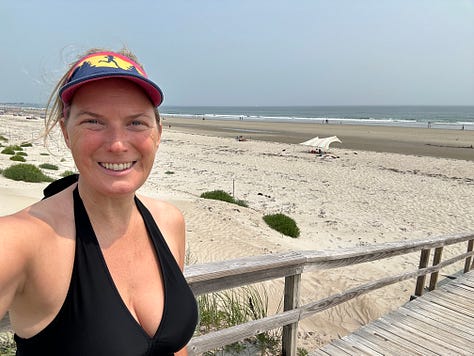


All Joy and No Fun—my mind pulled me back to the title of the parenting book by Jennifer Senior. No doubt these parents adored their kids, were proud of their kids, and wouldn’t trade their lives for anything. But I wondered if, deep down, they loved the 24/7/365 job of being a parent? Upon closer consideration, knowing what I knew now, I wasn’t entirely sure I would.
These doubts crept into the bedroom as Seth and I resumed lovemaking once I returned home. For the first time in five years, we started using condoms again. I believed that the odds of a healthy, viable pregnancy with my own eggs were so infinitesimally low compared to the stress and distress, the hope and hopelessness, of wondering every month if I might be pregnant, and if any potential pregnancy would last, and if we even wanted to be pregnant at this point in our lives, that it wasn’t worth the uncertainty. My periods had become erratic in the past six months, sometimes skipping months at a time as I barreled toward menopause, and I couldn’t bear to indulge in another dance with hope, only to be destroyed again. It was the final stage of giving up on my ovaries. Still, I couldn’t help but joke with Seth in a moment of passion, “Wanna make a baby?”
As the baby prospect grew less appealing, I returned to the possibility of adopting an older child, which was the idea we had started with two years earlier when we’d become licensed foster parents through our state’s Division of Children, Youth, and Families (DCYF). I had been in touch with our new Caregiver Coordinator throughout the winter and spring, but she had been less engaged than the one who had left last fall, and in April she had informed us that the Division was no longer working with adoptive families unless they were also willing to foster. The problem for us was that if we accepted a regular foster placement, we would be committed to helping that child reunify with their birth parents for up to 18 months, and we did not feel we could do so in good faith if our goal was to grow our own family. Also, that would be a long time to delay our family-building goals only to have the child leave and then have to start all over again. Either way, nothing was moving forward because the relicensing paperwork we had submitted back in December still had not been processed.
As soon as I returned home in June, I tried to reconnect with our Coordinator to find out the status of our relicensing and figure out how we could move forward. We had become licensed through DCYF two years earlier so we would be eligible to submit our home study for waiting children on the AdoptNH website, which also affiliates with AdoptUSKids. I had started looking at available children, but we would need a valid home study before we could inquire. Our interview had been completed in February but not yet written up. I was able to get a meeting with our Coordinator’s supervisor to move things forward, but then two more months went by without a response. Finally, in mid-August, I received an email from our Coordinator informing us that the next day would be her last day on the job, and her replacement wouldn’t start until September.
I had held out hope that there was a child waiting for us, and that it may be an older child who just needed a boost to launch themselves into the world. Adopting a teen would put us on the same timeline as our peers, and might be less exhausting than running around after toddlers. Seth and I remained open if the right fit came along, but the stress of working with DCYF and the trauma of our first failed match made us question that path. In any case, it seemed we would be waiting a while longer before we could consider moving forward.
In the meantime, my friend Anne’s baby was born—a beautiful little boy. She wanted to stay home alone with him the first ten days to bond, but I planned a visit on the eleventh day for some baby snuggles. I wondered what it would feel like to hold a newborn; my only experience with a brand-new baby had been the previous fall, when DCYF placed us with a newborn boy and I’d visited him twice in the hospital. I had entered the maternity ward thinking that baby might someday be mine, but DCYF called the next day and informed me that a family member had stepped forward to care for him, and our services were no longer needed. I never saw him again.
How would it feel to hold my friend’s baby, knowing that my egg donor was out there waiting for me, and I could potentially be holding my own newborn a year from now? Would the newborn smell and the weight of him on my chest trigger a hormonal response? Would it reignite my baby fever? Would it be sweeter than all the newborn Facebook reels I could ever watch?
I wondered what to bring the baby, and I realized that I had tucked away so many baby things over the years for my own theoretical child, it might be time to pass them along. But was I ready to part with all the moose onesies I’d collected, dating back to my first marriage? They had hung in my closet for over a decade, a sad reminder of a dream deferred. I’d squeezed our foster daughter into a couple of the 18-month outfits, but the 6-12 month sizes were unused.

On impulse, I plucked them all from their hangers, laid them flat for a photo, and then packaged them up with a note telling Anne I wanted her to use them until if and when I needed them (which wouldn’t be until her boy had outgrown them). “P.S. There may be a few tears on this card,” I warned.
The baby had just finished feeding when I arrived, and he was ready for a snooze. Anne passed him to me and I sank into the rocking chair with a six-pound boy scrunched up on my belly in the fetal position. He fell asleep as if he were in my womb, and I held his tiny body with both hands. He was warm like a lap dog, and I felt a wave of oxytocin release as I gently stroked the velvety blond hair on his neck. Anne and I chatted for two hours while he slept, and it was only my effort to reposition that roused him and got him rooting for his next meal. I passed him back to Anne and organized some bookshelves while she nursed.
Despite the bliss of baby snuggles, I was relieved to know I could hand him back to his mama and walk out the door to go climb a mountain. I could enjoy the baby without being the one stuck inside all day, trapped in the wake-feed-nap cycle. Anne seemed tired but blissful, and I knew I would be too if he were mine. But he wasn’t, and I still didn’t think I wanted to go through everything I would have to go through to maybe get what she had. I made it through my first baby visit without shedding a tear, and perhaps, again, with a shred of relief.
On my way home, I parked my van at the Randolph Town Forest to climb Mount Crescent. The trail was steeper than I remembered—or I was more out-of-shape than I’d realized, owing to the busy-ness of the two months since I’d returned home. Despite my best intentions, I’d only done a few short hikes all summer, besides my usual jogs around my neighborhood. I climbed slowly, stopping frequently to rest and enjoy the forest. Earthy moss and balsam fir filled my lungs as I listened to the susurration of the birch and aspen leaves. At Lookout Ledge, I sprawled across the granite to catch my breath and gaze across the valley at the Presidential range. Mounts Madison, Adams, and Jefferson towered over 5,000 feet, reminding me that I’d booked a hut-to-hut hike with my friend Becky and would be walking across that ridge the following week. I wondered how I would survive three days in the high peaks when I could barely climb an hour up Crescent.

But today, all I had to do was gaze at the Presis, and rest, and contemplate my existence. Life was pretty good, I realized, and I wasn’t convinced that having a baby would make it better.
I let the newness of this feeling settle in. For five years, I’d been saddled with this chronic urgency to start a family by any means possible, before some imagined deadline. Letting go of the urgency, the deadline, and even the idea of a family were new concepts to try on, stretch out, and settle into.
Since embarking on my six-month road trip, I had just started to feel happy for the first time in a long time. I had thought that meant I was finally ready to move on to the next phase of life and become a mom, where I’d find even more happiness and fulfillment. But what if, instead, it meant that I’d finally found the magic formula for my own happiness—zero stress and 100% freedom—and pursuing parenthood would derail that?
What if the perfect life for me meant bouncing between my mountain and lakeside homes in New Hampshire with frequent camping trips to the ocean… and rotating my New England life with seasonal road trips from Alaska to Baja… and being able to make it work because we don’t have the expense and responsibility of children? Yes, I had dreamed of doing all those things as a family, but we could barely afford this lifestyle as-is, so there was no guarantee it would work out financially or logistically with kids (most van-life families I saw on Instagram and YouTube seemed to disappear once their kids reached school-age, even if they made it work when they were young). The safest decision for me now, I realized, was to continue the status quo and feel into this kind of happiness and this kind of life.
I didn’t want the people who said “everything happens for a reason” to be right. I didn’t ever want it to be “right” that someone who desperately wants a family can’t have one. But I had to admit that childlessness may be the best option for me and my mental health—given the crippling anxiety I experienced when contemplating fertility treatments, and when trying to move forward with adoption.
I also realized that I didn’t have to convince myself that I didn’t want kids—I reminded myself that the desire was separate from the decision. I only had to accept all the reasons why it was the right choice for me not to have a family at this point in my life, and embrace all the ways my life could expand from that decision.
I breathed more balsam air on the Randolph ridge. My butt felt sore sitting so long on the granite, and it was time to get moving. I snapped a selfie with the Presidentials, picked up my teal Camelbak, and trod through the needle-laden duff of the boreal forest to the summit of Mount Crescent.
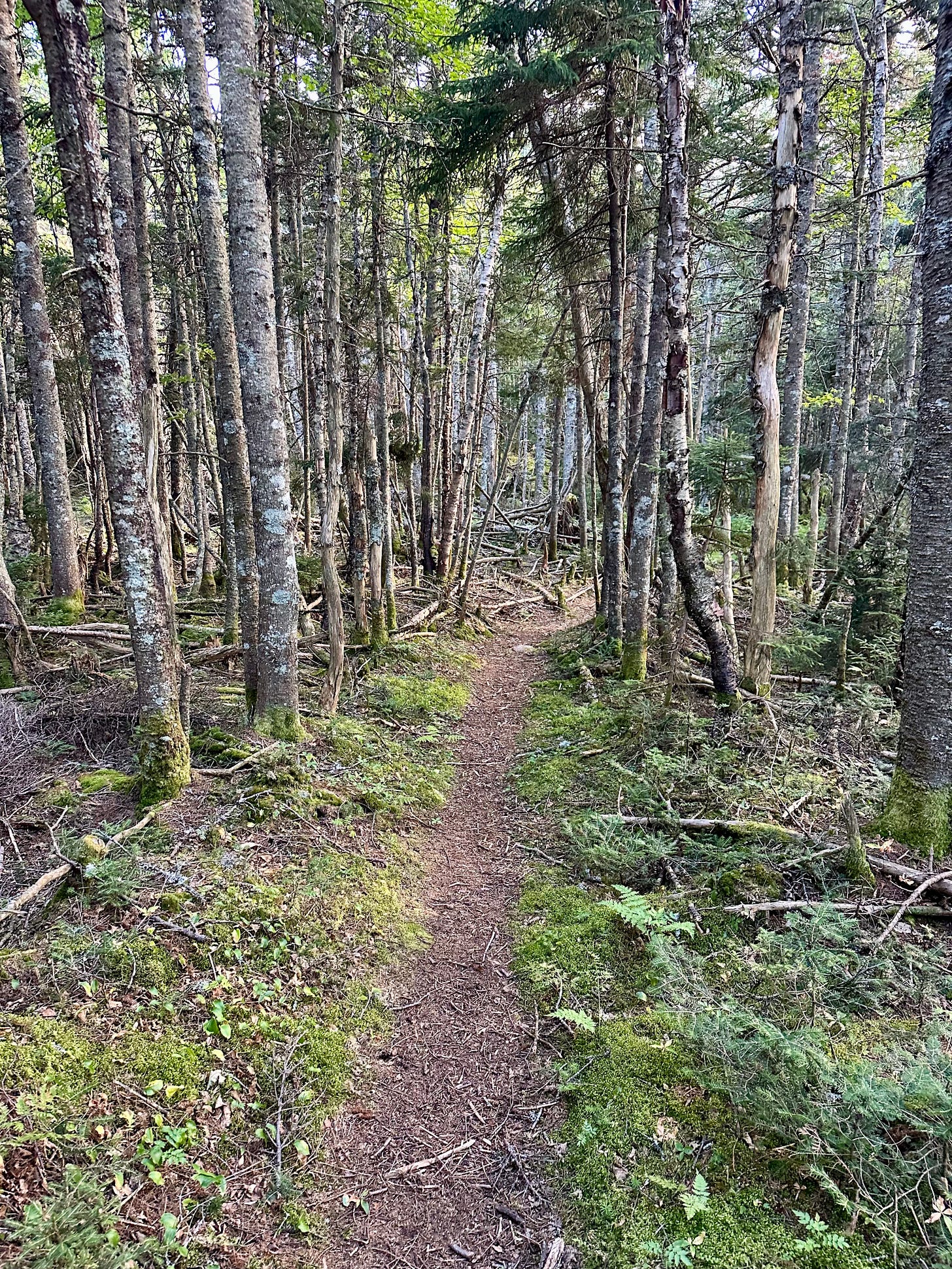
* * * * *
The more I came to accept and even embrace childlessness as a viable path for my life, the more energized I felt about the future. For five years, my parenthood path had been hoped-for but unfulfilled, and the weight of the uncertainty made it harder and harder to imagine a satisfying life. It had felt like if Seth and I never became parents, the path into the future would be cold, dark, and empty. Now I saw it brimming with possibility. It finally felt possible to accept childlessness without resigning myself to chronic grief and despair. There was a light at the end of the tunnel.
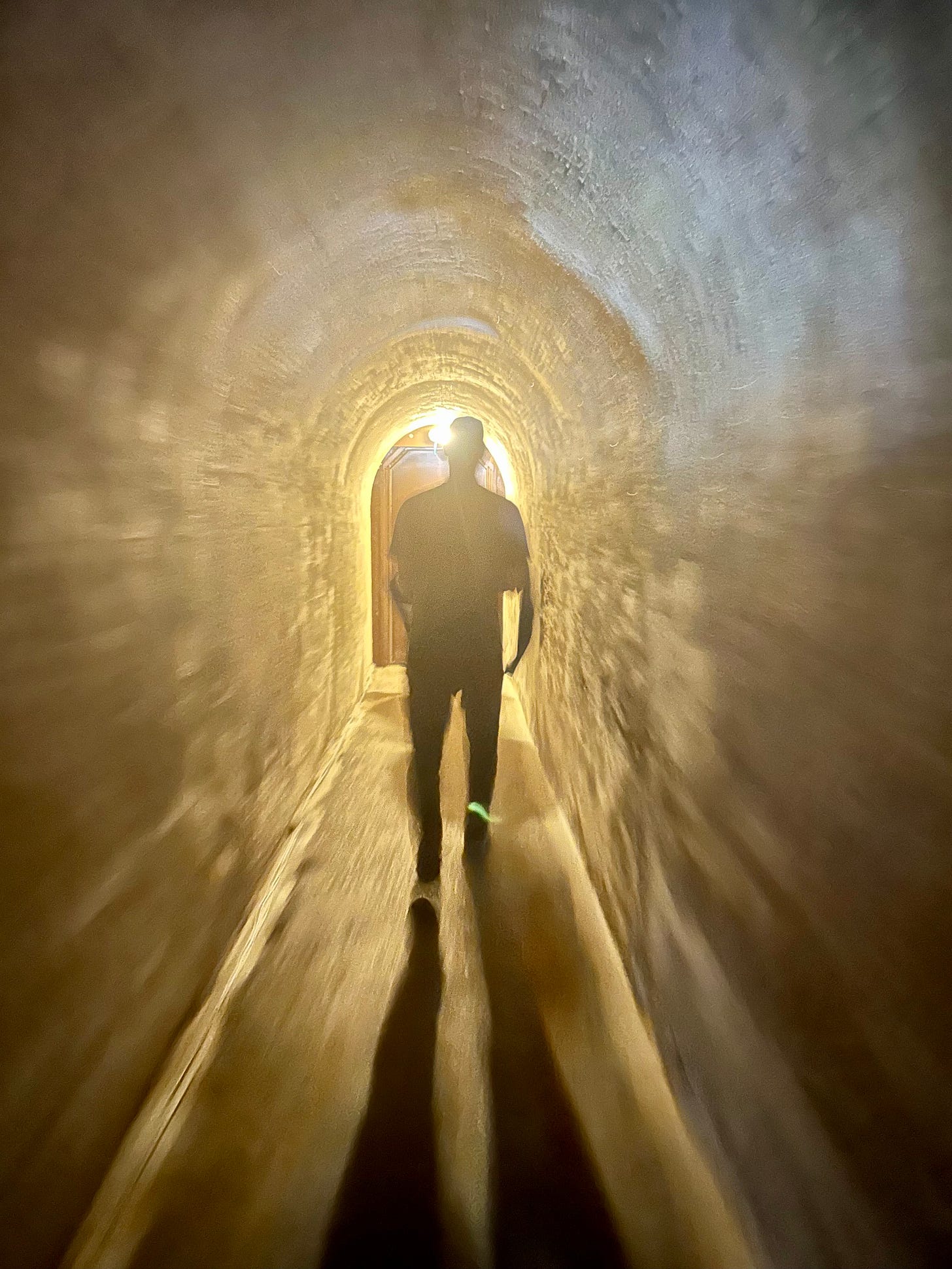
Other childless women had promised me this—they shared that they had struggled for years, but it finally got better; amazing, even. At the time, I never wanted to consider joining their ranks. I thought I would do anything to become a parent. Now I was beginning to realize that there was a limit to how far I could go, how much I could endure, how long I could put my life on hold before choosing the other path.
I returned often to that phrase, “separate the desire from the decision.” I had always desired a family. I would always desire a family. And, after five years of infertility, five miscarriages, six IUI cycles, and two failed adoption placements, I could decide that I had tried hard enough, the time to raise a family had passed, and I didn’t need to keep trying. Maybe, at 45, I didn’t still want what I wanted at 25 or 35.
But I knew, deep down, that if someone knocked on my door and handed me a child, and that child embraced me and called me Mama, and it was as simple as that, I would still say Yes. The yearning, the longing, the mothering instinct would win, if I didn’t have to fight so hard, and risk losing again.
And so I was learning to hold both truths at the same time—the wanting a child and the not wanting one; the endless grief of childlessness, and the endless possibility. I knew that there would never be a day I wouldn’t be reminded of the life I could have had, either way—as a childless woman watching the families frolic at the beach and the lake, or as the exhausted mother entertaining my children and watching the solo woman lounge on her float. I was learning how to be happy being childless, but whether I’d find happiness as a mother was a mystery. I could simply choose the safer path, the one that I knew from experience would promote my physical and mental health. Could I risk doing otherwise?
* * * * *
Vans beckoned everywhere I went.
When I first returned home in June, I was driving down Main Street and saw a Sprinter parked on the side of the road with out-of-state plates, and wondered where they had come from and where they were going. Were they visiting my town, or just passing through? I thought of all the places I’d stopped for mere minutes or hours, crossing paths with people’s lives before moving on. Now I was the local and they were the tourists.
It didn’t feel right.
On my way through the White Mountains, I was driving my 2003 Chevy Astro when I saw a Roadtrek camper of the same vintage as mine. I wanted to give the signature 3-finger Roadtrek wave, until I remembered that it made no sense; I was driving the wrong van.
On a trip to the southern part of the state for a medical procedure, my heart skipped a beat when I saw a camper van in the parking lot. After my appointment, I ate lunch in a strip mall that had a Planet Fitness, and I imagined myself making a home for the night in the parking lot, noticing it had a nice lawn in the corner where I could walk the dogs.
You know you’re a van life dog-mom when you get excited about a nice patch of grass in a strip-mall parking lot!
I took a few weekend and week-long summer trips in the Roadtrek, and my mini-home fit like a glove every time I stepped inside. The stress of my medical appointments and messy house and piles of bills melted away as soon as I simplified my existence to what fit on those four wheels.
Second-best were the weeks spent in my other old camper, my 1991 Winnebago, in the driveway at my in-laws’ lake house, falling asleep to a serenade of crickets and cicadas, and writing these three essays while bald eagles circled overhead.
Maybe my life was meant to be simple.
All of the striving and trying and pushing and pulling and bending-over-backwards I’d done my whole life to make everything happen had left me with a lot of stress and not a lot of happiness.
Simplicity suited me.
New York Times best-selling author Tom Ryan, who had been following my journey as a fellow writer and adventurer, sent me a hand-written card the previous year in which he offered:
“No matter what we tell ourselves, no matter what we try to force, the truth stands in front of us without budging.”
What was my truth, I’d been wondering ever since? I had wanted it to be one thing—family. I had wanted my happy ending to be a pregnancy or adoption. I could not conceive of the possibility of happiness in a childless life. But what if that was the life I was meant to live all along, once I learned to accept it?
I had started writing on Substack in December 2022 by posting a response to a piece in Cheryl Strayed’s Dear Sugar column, “The Beauty of What Is,” in which she reprinted her well-known letter “The Ghost Ship That Didn’t Carry Us.” A 41-year-old man wrote to Dear Sugar asking for advice on deciding whether or not to have children. Cheryl (Sugar) spoke of a poem in which Tomas Tranströmer talked about our “sister lives”—the ones we could have lived but will never know. Cheryl advised the man to answer the question from the perspective of his future self rather than giving in to his fears:
“Not regretting it later is the reason I’ve done at least three quarters of the best things in my life…. So much so, that I suspect that whether you’ll regret it later is the only question you must answer. It is the very one that will tell you what to do.”
I had revisited this piece while I camped at 4,000 feet in the Panamint mountains of Death Valley National Park in May, deciding whether to head east and claim my egg donor. Sitting on the bed in the back of my van, I thought, “Of course I’ll regret not taking one last chance to have a baby,” and I vowed to pursue IVF (until my anxiety shut me down).
But the truth is, I had absolutely no way of knowing now what I would or would not regret; what pregnancy and childbirth might do to my body and brain; what kind of parenting experience I would have, or what kind of child; what might happen to my marriage or my life in the coming years that would complicate things; or even how the dynamics of donor conception (or adoption) would play out in my family. I could imagine the perfect family scenario, but I didn’t want to think about all the imperfect ones (I am no stranger to intergenerational trauma).

A van-life friend had recommended the novel All Your Perfects by Colleen Hoover, about a couple struggling with infertility.
“I recently read a book that made me think of your situation, and perhaps the ending of the book is one that might be fitting to your story, too,” she emailed.
Not knowing how the story ended, I wasn’t quite sure what that meant, though she implied that it might not end with a baby. This intrigued me, so I started listening to the audiobook while camped by the Kings River in California, contemplating my decision to head home.
As I waffled with my commitment to IVF on the journey east, I had to take breaks from the book, but once I was home I resumed my nightly audiobook-in-the-shower routine. Still, I didn’t finish the book until three months later, at the end of August, after my shift toward accepting childlessness.
The final chapters were remarkably serendipitous:
“Where do you think we’ll be ten years from now?” the narrator, Quinn, asked her husband Graham, in a flashback to their first wedding anniversary.
Graham described a vision of having their own house with a big yard and two kids, a boy and a girl, with a third on the way. They would drive a minivan, and she would work from home as a writer, and he would have his own business.
”That sounds like the perfect life,” she told him.
“Or,” he added, “maybe nothing will change. Maybe we’ll still live in an apartment. Maybe we’ll be struggling financially because we keep moving from job to job. We might not even be able to have kids. So we won’t have a big yard or even a minivan. We’ll be driving our same shitty cars ten years from now. Maybe absolutely nothing will change and ten years from now our lives will be the same as they are now and all we’ll have is each other.”
Quinn smiled and told Graham, “That sounds like the perfect life too.” Then, in her narrator’s voice, she reflected: “And it does. As long as I have Graham, I don’t know that this life could be anything less than what it is now. And right now, it’s wonderful.”
I stepped out of the shower, sudsy and dripping, to replay that line over and over again. Only in my mind, I replaced Graham with Seth:
“As long as I have Seth, I don’t know that this life could be anything less than what it is now. And right now, it’s wonderful.” (Shitty old cars and all!)




That's a big question that can mostly feel crushing. I've spent the guts of 30 years only imagining the life with children that I struggle to see myself satisfied with the without. Xx
Oh wow, no words for part 3. I can relate to so many questions, observing people, thinking about all the possibilities, the question of if I've tried hard enough... Beautifully written and expressed as always 💚